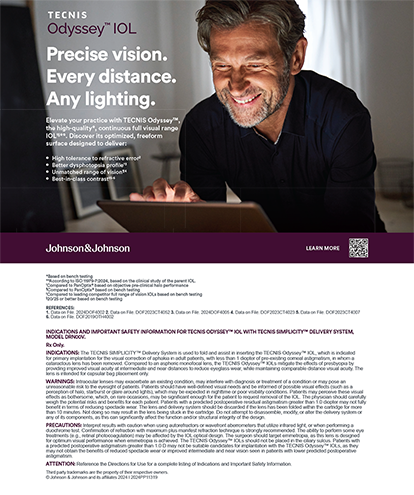
Aside from the capital outlay required, adding a new piece of technology to a clinic or an ambulatory surgery center (ASC) presents logistical challenges and may create uncertainties. A good rule of thumb is to expect the unexpected when purchasing new equipment. Sometimes, the speed bumps are predictable, and the center can steer clear. Most times, the rule of unintended consequences comes into play, and the adjustment process really begins only after onboarding new technology.
AT A GLANCE
• Incorporating laser cataract surgery early has proven to be positive in terms of the lessons our surgeons learned about how best to use a femtosecond laser for a procedure that had traditionally been done manually.
New and unique technology becomes a powerful recruitment tool for the practice.
• It is important to consider the potential impact on patient flow and surgical time when a new piece of equipment is being proposed for use in the OR.
• Any new piece of equipment requires comprehen- sive staff training.
BACKGROUND
The most recent piece of equipment we added to our surgery center was a femtosecond laser, and actually, it was our second such laser.
Around 2010, when the laser technology was approaching market actualization, we formed an ownership committee to explore the possibility of adding laser cataract surgery to our offerings. After careful consideration and a thorough review of the technologies both approaching and on the market, we decided that this was something we definitely wanted to offer to our surgeons and patients, but the specific platform we felt offered the most to our ASC, surgeons, and patients was not yet commercially available. We realized that, if we wanted to gain early experience with laser cataract surgery, we would have to acquire the only commercially available unit at that time. So in April 2011, we installed our first laser to perform laser cataract surgery.
Incorporating laser cataract surgery early in the game has proven a net positive in terms of the lessons our surgeons learned about how best to use the laser for a procedure that had traditionally been done manually. It also gave us first-mover status in our community, which we felt would have significant value, and it did! The process, however, was not as seamless as we had hoped. Incorporating a new piece of technology so central to our operations proved challenging, and some of our experiences provide insight into the complexity of adding any technology. In our case, we eventually replaced the initial laser platform we purchased with one that offered what we felt were several improvements. That first laser was a cutting-edge piece of equipment at the time of its purchase, but the rapid pace of technological advancement in ocular surgery can significantly shorten the life cycle of some very expensive equipment. We went on to purchase the laser system that we had originally identified as best meeting our needs, and we have not looked back. In fact, 95% of our 40+ surgeons currently perform laser cataract surgery.
THE RISK AND REWARD OF EARLY ADOPTION
The early adoption of technology can be a double-edged sword. On the one hand, a new piece of equipment can facilitate an innovative way to do surgery that may offer benefits. From a business perspective, new techniques can also help with positioning the center or practice as cutting edge and innovative. Within the center or practice, new technology can also create enthusiasm among the practitioners. If you have something new, and it is not available elsewhere, as was the case with our early adoption of laser cataract surgery, that technology becomes a powerful recruitment tool.
There are caveats. Generally speaking, all of the bugs may not be worked out in advance of a product’s commercialization, even if it is subject to regulatory scrutiny. Many companies refine their technologies after users gain access and provide feedback.
Moreover, a novel way of doing a procedure may introduce new challenges. When we brought the laser into our facility, every surgeon in our practice wanted to learn how to use it. As a surgery center, we poured time and resources into training—significant time and resources! Enthusiasm waned quickly, however, as our users encountered issues they had never experienced with manual techniques. In some cases, the capsulorhexis was frequently incomplete, and the laser did not really treat the nucleus in the way our surgeons were expecting. We went from 35 trained and certified users to about three in the course of a year.
At that point, the ownership committee had to review our decision to purchase the laser. The laser our committee was initially interested in had come to market at that point, so we decided to replace the first platform with technology that we felt better met our needs. This brings up another important question to ask when considering early adoption: How likely is it that new and competing technology will come to market soon after a product’s release, and how likely is it that the facility or clinic will have to replace the first piece of equipment? A difficult question for sure.
THE IMPACT ON PATIENT DYNAMICS
We had no idea what impact using a laser during cataract surgery would have on patient flow dynamics. We had a general idea that it would increase our surgical time and affect efficiency. After all, we were adding a step to cataract surgery, and we were asking the surgical team to operate with new techniques and a complex technology. Overall, we found that laser cataract surgery initially added about 10 to 12 minutes to the cataract procedure. For our facility, like all ASCs that had worked hard to create efficiencies around patient flow, 10 to 12 minutes several times a day seemed like an eternity.
It is important to consider the potential impact on patient flow and surgical time when a new piece of equipment is being proposed for use in the OR. It may be prudent to allot extra time for initial procedures so the team can work out the kinks, figure out the learning curve, and ultimately get comfortable with a new way of doing things.
TRAINING
Any new piece of equipment requires comprehensive staff training. In purchasing and then repurchasing a laser platform, we had to go through two rounds of training, and we were not sure if we could reignite the initial enthusiasm and get our surgeons and staff energized again.
We did our staff training on the new laser platform in two segments. In the first round, we held evening didactic lectures and wet labs led by the manufacturer’s representatives for the system operators and OR technicians to familiarize them with the technology. Then, we gave them hours of hands-on time to learn the fundamentals and advanced settings. We wanted to make sure that they could set up the equipment each day, prepare it for surgery, and handle common problems.
The second wave of training, again held after hours, involved small groups of surgeons. This time, it included the manufacturer’s representatives and our already trained staff members. The strategy allowed us to conduct mock surgical experiences with the entire team working together but with only one new learner per session to minimize distractions. Ideally, the surgeon training would take place soon before the surgeon’s first surgical day with laser cataract cases, and on that first day, he or she would perform a minimum of five cases to enhance retention of what was learned.
One element of training that we took on is less obvious. We knew that every patient who came into the center would have questions, so we felt it was important to educate the front office staff, technicians, and other center personnel about the laser. At a minimum, we wanted everybody in the center to be able to direct patients’ questions to the appropriate source.
CONCLUSION
Incorporating a new piece of technology rarely goes according to plan. The center has to stay flexible. A new technology’s benefit can be measured in multiple ways. First, it should be financially viable with a reasonable return on investment. Before purchasing new equipment, it is essential to have a reasonable estimate of what the return on investment would be. A second way to look at benefit is if a technology improves patients’ care. If adding a new laser or diagnostic tool will improve outcomes but appears to be a loss or break-even proposition, then a compromise to the bottom line might be necessary. We have not infrequently integrated a new technology that primarily had better outcomes as our focus, as opposed to financial gain. That becomes a philosophical discussion.
Part of knowing the return on investment of a given piece of equipment is understanding the potential demand from the surgeons who do surgery at the facility. I typically query our surgeons in advance about their interest in a new piece of technology; I ask for how many cases per month the surgeons would expect to use the technology. However, I have learned that our physicians tend to overestimate their enthusiasm, so it is wise to take their expectations with a grain of salt. When building your financial illustrations, take the aggregate number of cases the surgeons say they will do, and reduce it in half. Works every time!
There is no magic formula for onboarding new technology in an ASC, but planning carefully and being willing to expect the unexpected may help a center to avoid the unintended consequences a poorly planned purchase of new technology can have on the center or business.
Robert B. Nelson, PA-C
• executive director, Island Eye Surgicenter, Carle Place, New York
• rnelson@islandeye.net


